Unbroken 4Runner Keeps On Keepin’ On
Filed under: Weekly test drives, Autos
By John Gilbert
Generally when you review a new vehicle you can hardly contain yourself from gushing about all the fantastic new high-tech features and gadgets contained in it. And then there’s the 2019 Toyota 4Runner.
The 4Runner is solid, steady, consistent, free of surprises, and…completely familiar. Even if it looks a little bit different from the one we’ve known for a decade.
Toyota is an amazing company, and nobody can quarrel with its overwhelming sales success, which has been largely achieved by ignoring the styling trends and gimmicks in an automotive world that is seemingly passing it by. By ignoring the guidelines it helped create, Toyota has continued to build the same-old same old of some of its most popular vehicles, such as the Corolla, Camry, Tacoma, Tundra — and the 4Runner.
The RAV4 is different, having been restyled a few times to stay at the top of its popularity game, as Toyota’s top-selling vehicle as a compact SUV.
But go up one step to the 4Runner, the midsize stalwart of the line, and go back to when the fifth generation was brought out, almost a decade ago, Toyota’s reputation for durability and consistency won out over the trends toward latest-tech and gimmickry. Basically, if you are familiar with the 2010 4Runner, you are pretty much familiar with the new 4Runner. The company did make some styling changes for 2018, but the ongoing refinement is primarily under the skin, and is what makes the 4Runner keep 4Running.
Cynics have been accusing Toyota for years about building boring cars, because the emphasis on running forever through a trouble-free existence can cause observers to equate that to boring, compared to so many competitive cars. But overlooked amid the criticism is that people seem to find it comfortable to walk into showrooms and find something so familiar, and they seem to feel comfortable getting the newest version of something they trust.
The trucks and SUVs are the best examples of standing out primarily because they are unchanged. The best comparison might be made to link the Tacoma mid-size pickup and the 4Runner midsize SUV. There is some merit there, because basically, the tried and true Tacoma pickup underpins the 4Runner. You could say the 4Runner is a Tacoma with a body, or that a Tacoma is a 4Runner with a bed carved out of the rear.
A reliable source I know well in the business says it best: “With Toyota, the cars aren’t cool, but the trucks are.”
I’ve always thought it was interesting that the huge rivalry between Japanese giants Toyota and Nissan was best described by the battle between the 4Runner from Toyota and the Pathfinder from Nissan. Both came out about the same size, both about the same shape, both had strong engines and both were the springboards to vastly expanding SUV arsenals.
I personally preferred the Pathfinder, for a couple of peculiar reasons. When I would test a 4Runner, I liked everything about it, but it seemed I would bump my head on the roof as I entered, and again as I exited, and it also seemed that a lot of the switchgear location always required a few days for me to learn. The Pathfinder, on the other hand, felt custom made for me — good clearance for my head in and out, comfortable driving position. with everything right where my instincts and fingertips figured it should be.
That was a long time ago, but it continued to be a factor in my analyses year after year, even though I always accepted and acknowledged that it was me that was peculiar and not the vehicle.
Now that the 4Runner has been redone a bit for 2018, the new 2019 version is designed and arranged in a way that seems pretty near perfect. That means, it’s pretty close to the same as ever.
The test 4Runner I had for a week on the North Shore of Lake Superior came loaded with all the right stuff. It was the TRD (for Toyota Racing Division) Off-Road Premium model. It starts out with the stiffest platform Toyota engineers can build — as if the company has an unspoken intention to prove it can “out-Jeep” Jeep. Dedicated off-roaders are certain that only Jeeps can take on the most rugged off-road challenges, but those loyalists might be surprised to learn that the 4Runner can be ordered for comfort or in a form that can go anywhere off-road but with a bit more comfort. Read more
A7 Upgrades for 2019 Both Subtle, Substantial
Filed under: Weekly test drives, Autos
By John Gilbert
There I sat, in my own driveway, checking and cross-checking (well, it was still hockey season!) all the features in the 2019 Audi A7 quattro. My obsession was one thing in particular: the very neat little sunscreen that fits up in front of the long, sloping hatchback rear window.
It worked great for filtering out a lot of the sun and heat, but it was getting on toward evening now, and I wanted to locate the power switch that would drop the screen down flush to improve nighttime visibility out the rear.
There are so many switches and gadgets on the A7, as on most high-end cars these days, that it isn’t always easy to figure out what the heck the little icon is for on the various switches. And sometimes you have to get on the expansive information screen, which is a lot like a computer or iPad, and you find an indication that you can tap an electronic switch and get whatever job you want done.
I knew I would find it, but right then I was a half-hour into perusing all the switchwork and gadgetry in what was becoming a more and more futile exercise.
When an automaker is near perfection, sometimes its evolutionary changes feel a lot like no change at all. That’s a good thing, if the car they’re changing is already at the top of the scale. Audi is that way. The German company builds a full slate of cars nowadays, from compact to sporty to luxury, with a fleet of highly regarded SUVs of all sizes alongside.
But Audi is at its best when it comes to making luxury freeway cruisers, which handle and feel more like sporty sedans but are safe, beautiful and highly efficient. At the top is the A8, and the midsize is the A6, but now they have wedged a sporty, fastback version of the A6 in between and called it the A7.
When you line up all three, it’s very difficult to pick a favorite. The A6 and A8 look different because the A8 is longer, particularly the one that comes to the U.S., which is the A8-L — the elongated version only. Of course, the A7 looks markedly different than both of the others, because of the sleeker, fastback roofline and hatch under it. Personally, I think the A7 is the best looking of the batch, and I did review it as a 2018.
But it has undergone significant changes for 2019, so when a 2019 Audi A7 arrived for me to test drive and evaluate for a week, I studied it carefully to denote all the changes. Different platform underneath it, and a change in 3.0-liter V6 engines, from the supercharged hot one to a turbocharged hot one, still 2.0, and from impressive to…impressive. The interesting thing is that all three cars at the top of Audi’s luxury chain — the A6, A7 and A8-L — all use the same engine with the same power.
And it is so good, smooth and powerful, that nobody is going to complain, especially when you can get right about at 30 miles per gallon on a freeway trip. Of course, the A7 has quattro, Audi’s brilliant all-wheel-drive system, although it is changed considerably from the quattro of years past, which had itself been altered and revised repeatedly. Interesting, quattro put Audi ahead of Mercedes and BMW for those of us who drive in snow part of the year, but now that Mercedes and BMW have realized the inherent advantages of AWD and installed it or made it available on many models, Audi keeps refining its quattro to come at compromise from the opposite direction. Read more
Santa Fe is Hyundai’s Latest Leap Into Future
Filed under: Weekly test drives, Autos
By John Gilbert
Just when you think you have Hyundai all figured out, the South Korean car-maker-in-a-hurry turns your perceptions upside down. Again.
Hyundai made a corporate decision that after pretty well mastering the art of delivering small and medium cars that performed at about a class above while priced at about a class below expectations and market levels, the worldwide trend toward SUVs demanded attention. It was a logical progression for Hyundai, whose sales had jumped to 46 percent small SUVs.
To expand its fleet, about a year ago, Hyundai brought out the compact Kona, an amazing vehicle that won our award for New Car Pick of the Year for 2019. We are continuing an extended test of a Kona Ultimate, and we continue to be thoroughly impressed. Kona also won the International Utility of the Year at the Detroit Auto Show and has captured virtually every award within its grasp.
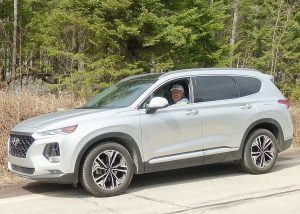
Author won’t give up the wheel, so No. 1 aide Jack Gilbert manned the camera. (Photo: Jack Gilbert.)
In its haste to fill every niche, Hyundai also completely redid its Santa Fe midsize SUV. The new Santa Fe is a totally different vehicle for 2019, made more compact than the outgoing Santa Fe but still leaving a nice space above the Tucson, which remains above the Kona. Nice, three-step size range, from Kona to Tucson to Santa Fe, each with its own personality and all three benefitting from Hyundai’s technology, safety and features, yet still aimed at economy and durability.
When they thought nobody was looking, Hyundai snuck out more new SUVs, a smaller one than the Kona, another mid-sizer, and a larger SUV bigger than the Santa Fe X. But wait! We can’t keep up. And even Hyundai doesn’t seem able to keep up with its own design and marketing traffic jam, so to speak.
While the Kona was winning all those SUV-of-the-year awards, the Santa Fe was virtually ignored, even from the time of its own introduction. The Santa Fe I wrote about at its introduction in the Utah mountains near Park City was nearly perfect from the standpoint of power, efficiency and technology. If you thought the old Santa Fe or Santa Fe XL were too big, and that the Kona was a little bit tight, the new Santa Fe plugged in perfectly. And it is good enough that it deserved some consideration itself for SUV of the year.
Several months have passed, and now the Santa Fe has gotten beyond its introduction and can be found in showrooms nationwide. But up here in Northern Minnesota, late winter has been perfect timing. This has been the winter that never ended, with a new snowstorm threatening to show up on the first weekend in May. Kentucky Derby in Louisville, shoveling anew in Duluth. Why wouldn’t you want an SUV with all-wheel drive?
So before we expand our consciousness to incorporate the reality that Hyundai now has seven — count ’em, 7 — SUVs under its name, let’s give the Santa Fe its due. Read more
Tiguan Grows Longer, Adds Third Seat Option
Filed under: Weekly test drives, Autos
By John Gilbert
As an SUV-buying society, we haven’t properly appreciated the Volkswagen Tiguan all through its existence. Now that it’s 2019, it’s still not too late, but the boundaries have changed.
For years, the Tiguan, Volkswagen’s compact crossover, was the company’s SUV, even when it wasn’t so much an SUV as a tall station wagon. It was always convenient for hauling a family and gear on trips, across the country or to the mall, or to hockey, soccer, baseball or basketball practice. It was solid, substantial, and performed well for both power, agility and gas mileage.
When the SUV craze not only hit but escalated rapidly out of control, companies that built cars soon realized that if they didn’t also build SUVs, they might soon be marketed right out of existence. I recall when Porsche built its first Cayenne, those of us in the invited automotive media assembled to drive the vehicles on and off a race track and off-road. The question on everybody’s mind finally got asked.
“Why would Porsche, a company that builds the best sports cars on the planet, bother building an SUV?”
The Porsche executive answered without hesitation: “So that we can continue to build the best sports cars on the planet.”
Those words ring true for every manufacture now, and not just because Porsche comes under the Volkswagen corporate umbrella. The other reason is that Porsche buyers also wanted SUVs, and they wanted high-end SUVs and were willing to pay a lot of money for them. The Cayenne gave Porsche buyer/owner types the chance to buy an SUV and stay within the Porsche family.
For Volkswagen itself, Beetles, Golfs, Jettas and Passats remained as good cars, great cars, maybe, but sales were shrinking as buyers were going elsewhere to find and buy SUVs. The SportWagen worked well enough, but more size was wanted, if not needed. So the Tiguan continued as an SUV, and Volkswagen added a couple larger SUVs, including the Atlas.
But a year ago, Volkswagen decided to lengthen the Tiguan. Buyers who liked it also wanted a third-row seat, and to meet the demand, or at least the request, VW lengthened the Tiguan and added a third row seat, which could fold down for added cargo space.
For 2018, Volkswagen sold two Tiguans, the remainder of the shorter model, and the highly promoted longer one. For 2019, the longer one is the only one still being produced. To meet all desires, VW makes the two versions different. Read more
Mustang Bullitt Blows Away All but Icy Driveway
Filed under: Weekly test drives, Autos

The 50th Anniversary Mustang Bullitt packs 480 horsepower, GT handling, special look, even in the face of impending storm.
By John Gilbert
When you review new cars, there’s never a good time to bid adieu to the really fun vehicles in which a week-long term goes by too fast. But when a mid-April, 8-inch snowfall hit Duluth, Minnesota, it’s probably best that my week-long test drive of a 2019 Mustang Bullitt ended prematurely.
Actually, I ended it three days before it would be picked up at my house, even though my term ended on the very day that the 50th anniversary of the movie “Bullitt” was released — the movie with the legendary chase scene that ultimately made Steve McQueen a superstar and the 1968 Mustang he drove an icon that has prompted Ford to make copies for two model years, 2019 and 2020.
Don’t get me wrong. There’s never a good time for a week-long test drive of a truly fun car to end. But this one arrived with the admonition that the Bullitt was shod with Michelin Pilot Sport high-performance tires on those classy 19-inch alloy wheels, so if it snows — park it.
It snowed, and I parked it. Knowing that those smooth, track-worthy tires are fantastic on a race track or high-speed freeway, but they have pretty much no traction if anything slippery is between the car and the pavement, I compressed as much driving as I could into the first four days it was in my control. It’s not unusual for snow to hit Minnesota in April, but after getting into the 50s, the nasty long-range forecast seemed especially mean.
For those old enough to remember the wonderful action-filled Steve McQueen movie from 50 years ago, it is a brilliant bit of strategy for Ford to bring out a replica bristling with modern technology as a reminder of the spectacular chase scenes filmed on the hilly streets of San Francisco, with McQueen, the late actor who thrived on hot cars and exciting chases. McQueen drove a hot, dark green 1968 Mustang with a tricked up V8 that allowed him to bound and bounc through wild street scenes while being chased by bad guys in a menacing Dodge Charger.
The 50th Anniversary Bullitt Mustang is the amalgamation of all that has been good about Mustangs through the ensuing decades, tempered by the latest engineering marvels such as a 5.0-liter dual-overhead-camshaft V8, juiced up to 480 horsepower and 420 foot-pounds of torque, regulated by a 6-speed stick shift that changes gears smoothly and keeps you in the power band, maxed between the torque peak of 4,000 RPMs and the power peak at 7,000 RPMs.
The kick you get from 0-60 capabilities of 4.5 seconds, and — according to Car & Driver magazine — 0-150 in 23.1 seconds(!) is enough to cause you to remember those hot cars of the late 1960s and 1970s, or to recall a weekend at a drag strip watching the top racers compete.
The biggest thrill of the Bullitt comes when you climb into the bucket seat, hook up the safety belt, step on the clutch, and push the starter button. The explosion of finely tuned power rumbles out through four exhaust tubes and, unless you find it annoying, is worth the chill that runs up your spine and back down. Let the clutch out — gently now — and zap! You’re off.
The Mustang GT has similar power and features, but Ford added punch to the Bullitt and assures it of being an instant classic during its two-year run, in Dark Highland Green or black only. I’m surprised Ford’s market wizards didn’t make it in that dark green or silver, which would allow non-movie buffs to buy a Silver Bullitt.
The base Bullitt is just under $50,000, while the test car was just a tad over $52,000. Those crafty folks at Ford know that Mustang zealots won’t pay ridiculous prices for just any Mustang these days, so there are specialty versions like the GT, the Shelby 350 and the newer Shelby 500, which has even more power. But every Mustang zealot who knows a door from a steering while will pay a lot for something that conjures up the image of the most famous Mustang in cinematic history,
The front end of the Bullitt has been pinched down for style and aerodynamics, with a narrowed horizontal grille and small slits to house the LED headlights, and there are a couple of active hood vents to eliminate some of the hot air that can build up in the engine compartment.
The wonders of modern auto technology mean that unlike the original, which could shake and rattle in short order, but was fast enough and handled well enough that you didn’t care, this one handles with near flawless race-car precision. Sure it’s a little stiff as you bounce across potholes, but it stays firm and flat around the tightest curves, with responsive steering and startlingly efficient braking from the big red Brembo brakes.
In the never-ending battle against Camaros and Challengers, Mustang has gone high-tech with the DOHC engine. Having overhead cams instead of pushrods means the Mustang will rev easily to the 7,500 red line, but as fun as that is, the Bullitt is also an every day driver. The fantastic exhaust note might get tiresome to some, although I fall into that group who would find it only and always exhilarating. The DOHC, the 5.0 V8 cruises effortlessly at freeway speed. I noted at 70 mph it was registering only 2,000 RPMs on the big tachometer, which isn’t much higher than idle speed. A pushrod engine would be working harder for that speed, and not delivering as much efficiency.
I got 24 miles per gallon except in only city driving, where — and Duluth’s hills are a lot like San Francisco’s, now that I think of it — the mpg dropped down to around 18. I confess, though, that I was unable to suppress the urge to blip the throttle going up, for bursts of street-legal acceleration, and on the way down, where it held speed descending those hills at moderated speed.
Actually, the Bullitt blips itself, so to speak, on every downshift, where you hit the clutch, and as you drop the shift lever down a gear, the engine automatically revs to matching engine speed. That may prevent an unsophisticated driver from a jagged downshift that might pitch hit wife toward the windshield, and it also supplies the perfect alert signal that you are driving one of the hottest but also most manageable sporty cars on the planet.
The console has the shift lever, with a giant white ball for a hand grip, and on the center stack, below the navigation screen there is a row of horizontal toggle switches, which are a neat way to control various features. The Bullitt Electronics feature everything from cross-traffic alert to the premium audio system and all the connectivity. Suspension adds MagnaRide dampers for precise handling through the independent rear suspension, and the usual safety features, such as stability control and controllable modes for comfortable ride up to track stiffness are there.
As my week seemed to hurry by, the forecasted storm that was supposed to hit all of Minnesota and all of Wisconsin did hit, with southern reaches of Minnesota getting up to 15 inches of snow. It was delayed in hitting Duluth, which, located on the pointy westernmost tip of Lake Superior, we sometimes get hit hard and sometimes find storm fronts diverted. This time, the wind was blowing in hard out of the east, at an estimated 35-50 mph in a straight line, and the next day we learned that it hit a measured maximum of 71 mph. That pushed the front a bit to the west, for a while at least, and gave me another day to drive, driving rainstorm or not.
I couldn’t resist driving down by the Aerial Bridge at Canal Park to shoot some photos of the giant waves rolling in, higher than the piers that reach out into the lake. Then I drove up the North Shore a ways, to shoot the spectacle of the waves crashing off the shoreline rocks, just for background for the Mustang Bullitt. By Thursday night, the storm was about to change from rain to snow, so I drove up our rural highway, pulled into our driveway, and backed the Bullitt up against the garage.
Sure enough, we got hammered by 8-plus inches of the wettest, heaviest snow of the entire winter. Shoveling was a weight-lifting project. I left the Bullitt under its snow blanket and drove other vehicles through the weekend. The fellows from the Chicago car-distribution site were arriving Monday morning to retrieve the car, and my plan for the snow cover on our driveway to melt by then didn’t quite work out. The snow had melted off the car, but the driveway was still under several inches of hard-packed snow, which greatly resembles ice.
When the drivers arrived, I suggested that while they are expert drivers, I know the odd little rise in my driveway, and the delicacy with which a car with high-performance tires needed to attack it. I got it moving, and tried to maintain speed as I got to the last part of the driveway, then only spun. Three or four more times I tried, backing up and trying to build enough speed to make the little rise at the end. Finally I backed up to a bare asphalt patch for some rear traction, figuring that might work. But as soon as I tried to give it a tiny dose of gas, the Mustang’s rear end shot to the left. I counter-steered, but both left side tires were immediately over the lip and off the road, and the car was hung up on the hard-packed snow.
We tried shoveling, putting de-icer and gravel down, but any attempt to engage the clutch caused the tendency to go farther off the road. We gave up, and I called Triple-A. A young fellow showed up with a gigantic wrecker in a half-hour, and with his modern devices was able to quickly pull the Bullitt out of danger, and out to our road. When he unhooked it, he asked if we could wait a second while he shot a few photos of the car, and he called his grandpa to notify him of the prize he just rescued.
“It’s not every day we get to tow a Bullitt,” he said, grinning broadly.
We gave him a ride in the car, and it blew his mind. He is ordering a special Mustang with a gigantic crater engine, but now he’s thinking maybe the Bullitt’s 480 horsepower are enough. I assured him this was a better prospect, from the standpoint of all-around driving and handling. And you can’t duplicate the sound of the Bullitt engine.
So the car left town and headed toward Chicago, because once out of our driveway, the snow had pretty much been cleared or melted. While I pondered what the 50th Anniversary Mustang Bullitt might be like with Nokian Hakkapelliita tires mounted instead of Michelin Pilot Sport summer tires, that thought was over-ridden by my hope that I might get another crack at that car anytime from May through November.


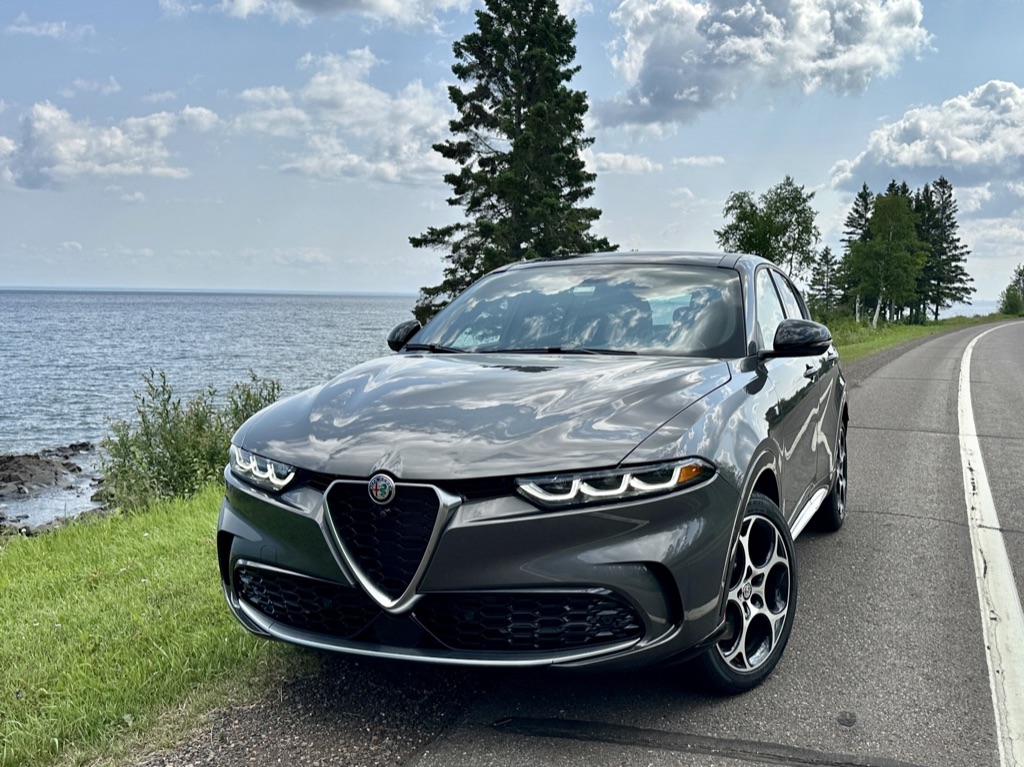


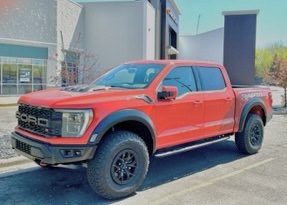

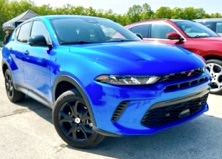


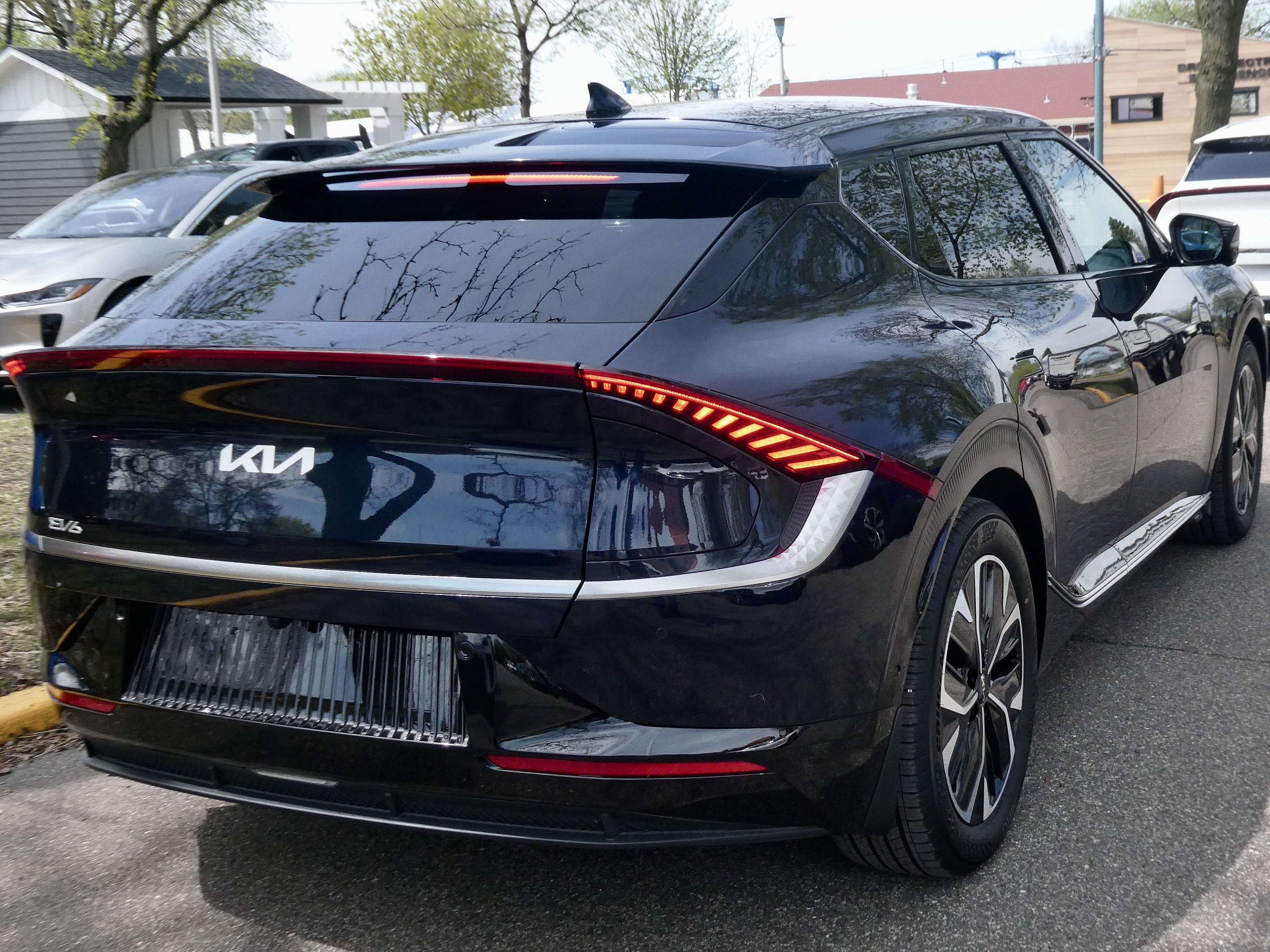
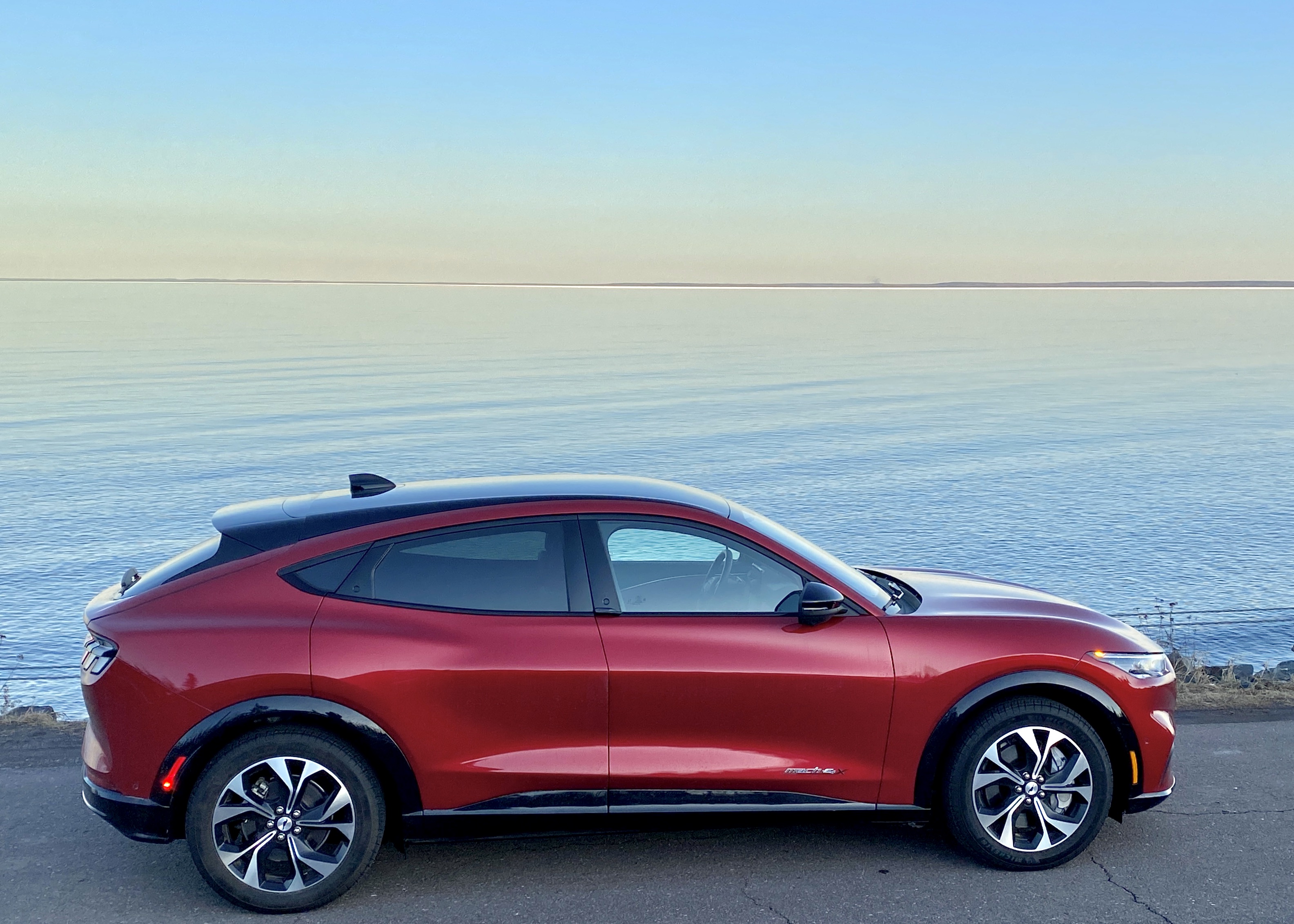
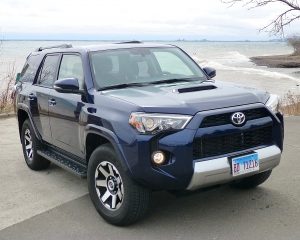
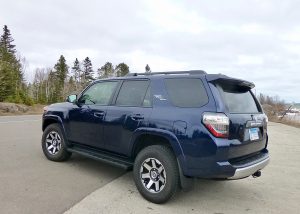
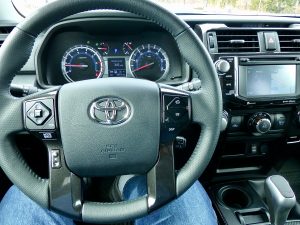
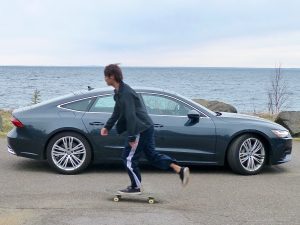

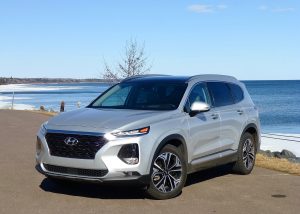
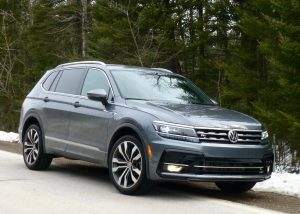
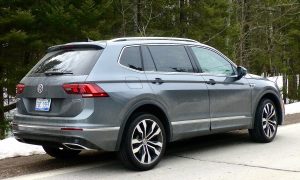
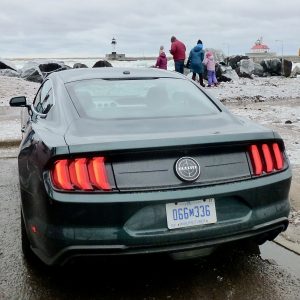
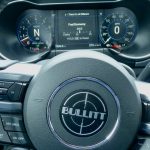

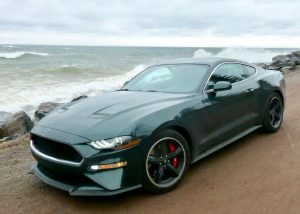
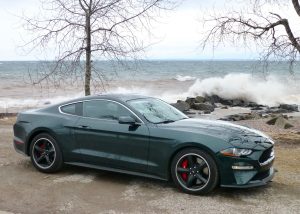

 John Gilbert is a lifetime Minnesotan and career journalist, specializing in cars and sports during and since spending 30 years at the Minneapolis Tribune, now the Star Tribune. More recently, he has continued translating the high-tech world of autos and sharing his passionate insights as a freelance writer/photographer/broadcaster. A member of the prestigious North American Car and Truck of the Year jury since 1993. John can be heard Monday-Friday from 9-11am on 610 KDAL(www.kdal610.com) on the "John Gilbert Show," and writes a column in the Duluth Reader.
John Gilbert is a lifetime Minnesotan and career journalist, specializing in cars and sports during and since spending 30 years at the Minneapolis Tribune, now the Star Tribune. More recently, he has continued translating the high-tech world of autos and sharing his passionate insights as a freelance writer/photographer/broadcaster. A member of the prestigious North American Car and Truck of the Year jury since 1993. John can be heard Monday-Friday from 9-11am on 610 KDAL(www.kdal610.com) on the "John Gilbert Show," and writes a column in the Duluth Reader.